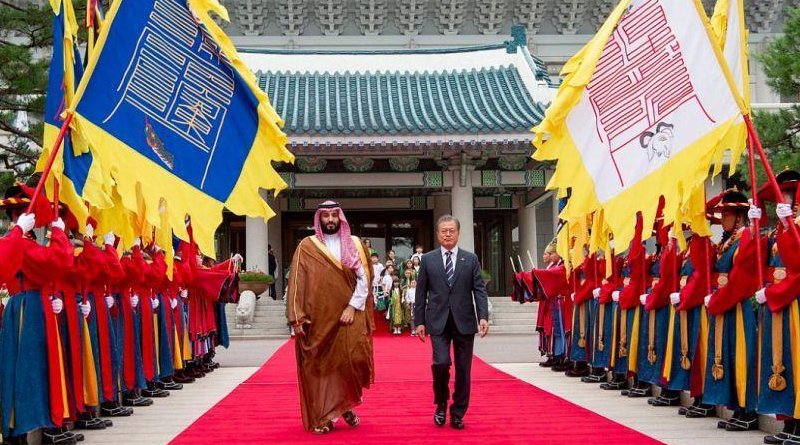Saudi Arabia’s Substantial, Expanding Ties With South Korea – Analysis
Crown Prince Mohammed bin Salman’s visit to South Korea before the G20 summit in Osaka can be seen through the lens of a unique bilateral relationship between the Arabian and Korean Peninsula countries. It is important to remember too that the then-deputy crown prince noted at the 2016 G20 summit that: “Within international society, South Korea is the latest country that successfully transformed itself within one generation, and it is a model for growth in Saudi Arabia.”
This high-level visit is important and a little recent history adds context.
South Korean government officials quickly moved to demonstrate the state’s willingness to use its resources to meet Saudi Arabia’s new push for economic and social transformation early on. The first such effort was when then-Prime Minister Hwang Kyo-ahn met with King Salman in May 2016. Hwang emphasized that Saudi Vision 2030 was “a perfect-matching project to Korea.” The momentum continued to build up to a September 2016 meeting between then-President Park Geun-hye and Mohammad bin Salman at the G20 summit in China, when South Korea pledged “to closely cooperate with Saudi Arabia for the Saudi Vision 2030’s success” and “to send an advisory group to design the economic development plan.”
Unfortunately, South Korea’s efforts ended in October 2016. The Korean political landscape changed dramatically and, from Seoul’s point of view, a moment was lost with the Kingdom. To make matters worse, South Korea’s domestic problems coincided with King Salman’s historic tour of Malaysia, Indonesia, Japan and China in March 2017. South Korea was excluded despite the fact that it is one of the largest consumers of Saudi Arabian exports and potentially a significant partner and investor in Vision 2030. Seoul could not host such a high-profile visit in the midst of the chaotic, months-long political chaos.
Fast forward to today and we see the relationship beginning to grow again. Saudi Arabia is currently South Korea’s most important economic partner in the Middle East and its top trading partner, with an annual trade volume of $250 to $300 billion. Saudi Arabia is also the No. 1 destination for South Korea’s foreign investment, which was approximately $3.1 billion from 2014 to 2016 and is continuing to grow. Unfortunately, the scope of these interactions is narrow and limited and both countries are seeking an expansion. For instance, more than 90 percent of South Korea’s imports from Saudi Arabia are of oil, and South Korea’s exports consist mostly of automobiles and construction equipment. The two countries are looking for a new balance with Vision 2030 in mind.
South Korea takes Vision 2030 very seriously. Korean companies have previously focused on exporting “Made in Korea” products, such as cars, electronics and machinery, to the Kingdom. However, they now want to move beyond simple trade transactions and pursue a cooperative and robust “Saudi” strategy. The expansion of relations between the two countries is focusing strongly on mutual benefit, especially in specialized joint ventures.
The energy angle is important because of its geopolitical component. In 1991, Saudi Aramco became the biggest shareholder in South Korea’s S-Oil Corporation, and this month it gained a new Saudi CEO in Hussain Al-Qahtani. In April this year, the Saudi energy giant also bought a 17 percent stake in Hyundai Oilbank for $1.2 billion. Hyundai Oilbank’s purchases of Saudi crude are set to rise from the current level. Korea National Oil Corporation (KNOC) data showed that the company bought about 15.5 million barrels of oil from the Kingdom last year. S-Oil’s launch of its Ulsan plant this week will help to shape the future of the East Asian energy picture.
Saudi-South Korean cooperation is setting the stage for further adjustments in Saudi oil economics with East Asian countries, which take into consideration increasing American supplies to some of these countries because of the pressure of sanctions on Iran. This action is tied to the ongoing effort to push Iran out of the East Asian energy market completely. It should be noted that the US is raising the amount of oil it sells to South Korea.
Perhaps the most important angle of the visit is nuclear energy. South Korea wants to develop nuclear power projects in Saudi Arabia and the state-run KNOC has been shortlisted in efforts to construct such plants in the Kingdom. The Saudi decision to develop peaceful nuclear technology comes at a time when it has several options for transferring these nuclear technologies from South Korea, Russia and the US. The changing or killing of any such deal that is already in process, such as with the US, would have geopolitical implications.
The Trump administration is moving forward with nuclear power reactor sales to Saudi Arabia. The prospects for a “123 agreement” on cooperation between the two countries are part of the sale process, which is naturally wrapped up in Washington politics. Now, Saudi Arabia is entertaining the South Korean bid more seriously as another option in a competitive market.
Overall, South Korea’s technology and manufacturing expertise, pool of skilled engineers and labor, and extensive experience in economic development and trade are extremely relevant to Saudi Arabia’s core objective of achieving the goals of Vision 2030. The two countries’ mutual needs are substantial and balanced from Seoul’s point of view, and areas of competition and conflict remain minimal and within the confines of an expanding relationship. The visit of Crown Prince Mohammed to South Korea is one of the keys to Saudi foreign policy success in East Asia. Seoul’s neighbors are watching closely as to what happens next.

